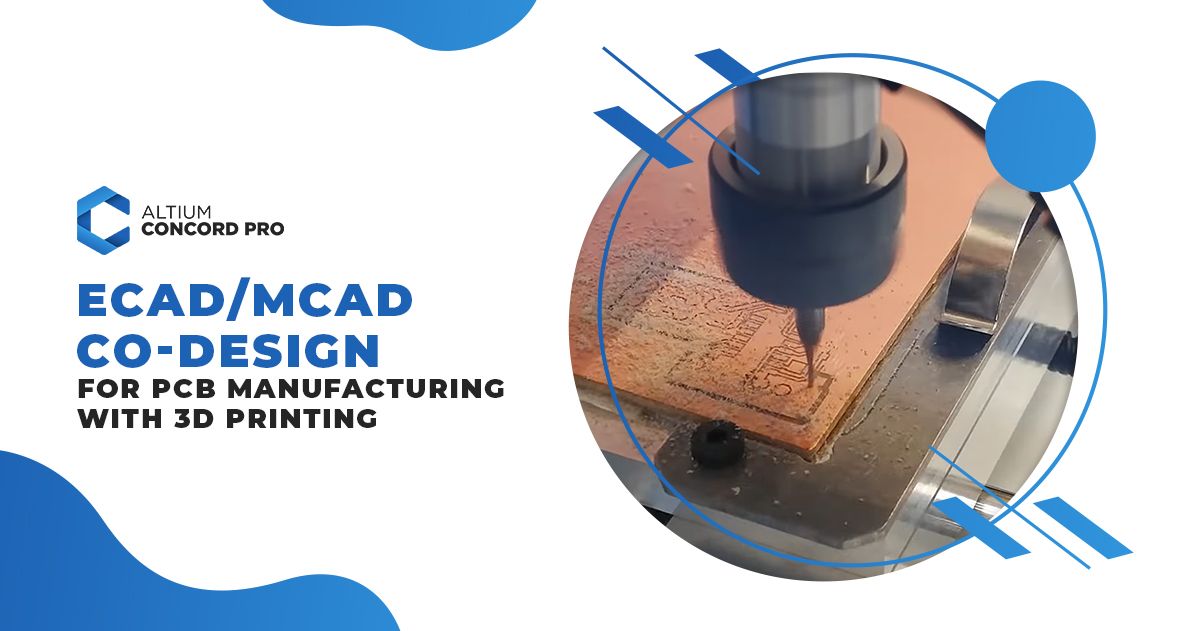ECAD/MCAD Co-design for PCB Manufacturing with 3D Printing

Table of Contents
It is ironic that PCB design has helped drive the adoption of new technology in all industries, including manufacturing automation, yet PCB manufacturing processes themselves have not seen radical innovation for many decades. Some innovative companies are looking to change this and are driving PCB manufacturing into Industry 4.0.
3D printing is already driving new manufacturing methodologies in every industry, such as “lights out” and digital manufacturing. PCB manufacturing is no exception, with some notable companies providing complete systems for rapid prototyping of PCBs in a single run.
This is where ECAD software has some catching up to do. Designers who want to create PCBs for use in 3D printers tend to use ECAD programs to design their schematics and PCB layouts, and then they need to recreate their layouts in mechanical modeling software. Thankfully, there are new ECAD/MCAD collaboration tools that save designers a significant amount of time when creating PCBs for manufacturing with a 3D printer.
Design for Additive PCB Manufacturing
When designing PCBs for additive manufacturing, the mechanical aspects of a design take on a new level of importance. Using 3D printing for fabrication gives designers much more freedom to create new interconnect architecture, boards with unique shapes, and even boards with non-planar geometry. This includes molded interconnect devices, printed components on curved boards, and even fully flexible PCBs. Designers are freed from many of the constraints imposed by traditional subtractive PCB manufacturing processes.
Any designer that wants to create a PCB for use in an additive system will need to consider the particular aspects of their desired additive manufacturing process when designing their board. Different additive systems are specifically adapted for use with different materials, and not all boards will be universally manufacturable with every additive system. Different materials will place different constraints on the planarity of a given board, on the manufacturable interconnect architecture, and on the mechanical properties of a finished device.
The right additive manufacturing system can print designs much smaller than this
In addition to the material constraints, various additive processes have limits on 3D printing resolution and require different run times and operators with different skill levels. In terms of design, some processes will only be usable for additive PCB manufacturing on rigid substrates, rather than printing substrates and conductors simultaneously. Printing resolution is an important mechanical aspect, as this determines the smallest size of a conductive or insulating feature that can be 3D printed in a PCB.
Designing for Different 3D Printing Processes
Perhaps the most important advantage provided by 3D printing is that designers have freedom to create unique interconnect architecture that would otherwise be un-manufacturable with traditional PCB manufacturing processes. This allows architectures like ELIC, VeCS, and unique microvia designs to be directly deposited on a PCB, both with planar and non-planar architecture.
The particular 3D process used will determine whether the substrate and conductors in a PCB can be 3D printed simultaneously—as in inkjet or aerosol printing—or whether a dielectric insulator and conductors must be printed on top of a rigid substrate—as in material extrusion. Other processes, such as powder bed fusion or selective laser sintering, are not the best choices for 3D printing in PCB manufacturing.
Typical print head for fused deposition molding
Some innovative additive manufacturing companies are releasing their own plugins for MCAD programs that help designers adapt their design for use with an additive manufacturing system. When you work with electrical design software that synchronizes with these MCAD programs, you now have a full suite of electrical and mechanical design tools to create PCBs for use with additive manufacturing systems.
Final Thoughts
In many industries, such as aerospace and automotive, additive manufacturing systems are being used to complement traditional manufacturing and assembly processes. The simplified design architecture and layer-by-layer printing steps used in additive manufacturing processes carry similar or lower costs than traditional subtractive processes. As a result, additively manufactured components tend to have lower weight, less material is wasted during manufacturing, and the finished parts can still be used as part of a traditional assembly process.
PCB manufacturing is no exception. A board can be fully printed, either on top of a rigid substrate or in its entirety as a single device, and the finished board can then be sent through a traditional assembly process. Manufacturing engineers and designers should expect future additive PCB manufacturing systems to be integrated with automated pick-and-place and soldering machines in order to eliminate manual assembly steps.
The layout, simulation, and verification tools in Altium Designer® can now be integrated with the MCAD collaboration features in Altium Concord Pro®, giving designers a complete tool set for designing for additive PCB manufacturing. The ECAD features in Altium Designer give designers the tool set required for creating a full electrical layout, and Altium Concord Pro allows a complete electrical model to be imported into popular MCAD programs. The mechanical and electrical aspects of a board can be designed in parallel, ultimately saving designers a significant amount of time and making it very easy for a device to be designed for use with an additive manufacturing process.
Contact us or download a free trial of Altium Designer and Altium Concord Pro. You’ll have access to the industry’s best routing, layout, simulation, and MCAD collaboration tools in a single program. Talk to an Altium expert today to learn more.












